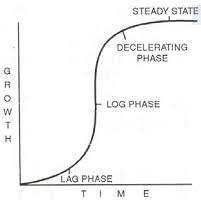1
Question
In the sigmoid growth curve given by the side, the alphabets indicate the sequence of events. Choose the correct option where the alphabet specifies the event.

In the sigmoid growth curve given by the side, the alphabets indicate the sequence of events. Choose the correct option where the alphabet specifies the event.
Open in App
Solution
The correct option is A A = Diminishing growth, B = Exponential growth, C = Slow growth, D = Stationary growth

The following figure represents sigmoid population growth curve which is divided into three phases- exponential phase, transitional phase and plateau phase. Initially the growth starts off slowly and is fastest in the exponential phase as during this phase birth rate increases than the death rate. Further the growth starts to decline due to diseases, predation and competition. Population is zero during last phase when carrying capacity is reached which is the maximum population size which the environment can support. Thus, the correct answer is option C.
Thus, the correct answer is option C.
Suggest Corrections
0
View More
Join BYJU'S Learning Program
Join BYJU'S Learning Program
